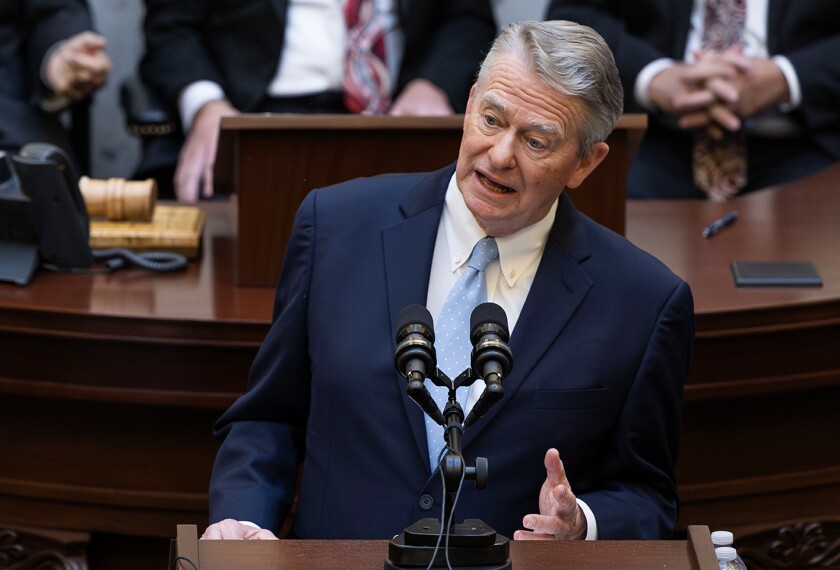Here are summaries of recent annual addresses by governors around the country.
California
Gov. Jerry Brown (D) • Jan. 23
In response to President Donald Trump and his aggressive stance on immigration, Brown promised in his State of the State speech to protect California’s immigrants, pledging that the state would “defend everybody—every man, woman, and child—who has come here for a better life and has contributed to the well-being of our state.”
Several California school districts have pledged to protect the status of their undocumented students, and voters overwhelmingly voted in November to end nearly 20-year-old restrictions on bilingual education programs in public schools.
Brown also emphasized in his speech that he has added “tens of billions” more dollars to the state’s education budget. Earlier in January, he proposed to increase his education budget by more than $1 billion in fiscal 2018 despite an expected state revenue shortfall.
—Daarel Burnette II
Illinois
Gov. Bruce Rauner (R) • Jan. 27
Education was a significant piece of the governor’s annual address to legislators, in which he outlined 10 long-term goals including expanding school choice for children attending academically struggling schools, building a “comprehensive, consistent, objective student-growth measure not necessarily based on the [Partnership for Assessment of Readiness for College and Careers] exam,” and growing the state’s early-childhood education programs.
Rauner also said the state is “committed to eliminating wasteful bureaucracy, putting more money into our classrooms, freeing up our teachers to teach, and holding our schools truly accountable for results.”
He didn’t give much detail on the initiatives, however, or any budget specifics.
Last month, Rauner and several Republican legislators proposed a bill that would allow the state to take over the financially struggling Chicago school system. Most notably, the bill would allow the district to declare bankruptcy and establish that the state would not be liable for the school district’s debt.
—Daarel Burnette II
Maryland
Gov. Larry Hogab (R) • Feb. 1
The governor gave K-12 education funding a high profile in his State of the State address, saying that in addition to fully funding the legislature’s K-12 funding formula this year at a proposed $6.4 billion, his budget proposal includes $334 million for school construction.
He also advocated passage of a bill that would facilitate charter school approvals in Maryland, and pushed to add $2 million to a $5 million voucher program that lets low-income students attend private schools. That investment would help children who are “trapped in persistently failing schools,” Hogan said.
—Catherine Gewertz
Massachusetts
Gov. Charlie Baker (R) • Jan. 24
The governor encouraged lawmakers to create more “empowerment zones,” which allow decisionmaking at the school level, rather than the district level, and “create more flexibility,” he said.
Baker previously supported a failed effort to lift the state’s cap on charter schools. He has praised empowerment zones, modeled on an effort in Springfield, Mass., as a way to “allow educators to make the changes necessary to provide a better learning environment for our kids.”
Baker also encouraged the state’s board of education to use its power to take over “struggling districts.” Existing takeovers of three districts have “demonstratedthat state takeovers can offer significant benefits to students, parents, and teachers in schools that need our support,” Baker said.
—Evie Blad
New York
Gov. Andrew Cuomo (D) • Jan. 17
The governor—who held a series of speeches on various policy topics around the state this year, rather than a single State of the State address—said in a speech in Albany that he is proposing to increase K-12 education spending by $1 billion for the 2017-18 fiscal year. The state spends around $60 billion a year on K-12 education.
Cuomo also proposed on an earlier leg of the trip to provide free tuition at state colleges and universities for students whose families make less than $125,000.
“College is a mandatory step if you really want to be a success,” Cuomo said. “This society should say, ‘We’re going to pay for college because you need college to be successful.’ ”
—Daarel Burnette II
Pennsylvania
Gov. Tom Wolf (D) • Feb. 7
In his third budget address to the Pennsylvania legislature, Wolf touted recent efforts to restore the previous administration’s “devastating” cuts to education funding and pledged $125 million in new state money for K-12 schools. Wolf’s budget proposal also called for $75 million in new money for early-childhood education.
“Parents and teachers will no longer have to spend their summers worrying about whether the school doors will open in September,” he said, referring to several years marked by school-budget crises across the state.
The $32.3 billion spending plan for fiscal year 2018 includes $12.8 billion for pre-K-12 education. It would need to be approved by the state’s Republican-controlled legislature.
—Benjamin Herold




